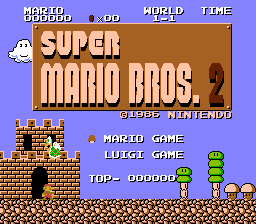Super Mario Bros.: The Lost Levels
|
|
Super Mario Bros.: The Lost Levels (Super Mario Bros. 2 in Japan) is a modified version of Nintendo's Super Mario Bros. It was first released in Japan on June 3 1986 for the Famicom Disk System; it is notable for being undeniably the most difficult game in the NES Super Mario series.
| Contents |
Super Mario Bros. 2 vs. Super Mario Bros.
Super Mario Bros. 2 does not have a two-player game. Instead, one may play as Mario or as Luigi. Luigi can jump higher and farther, but Mario is a more agile runner, with less "braking distance" (a difference not preserved in later versions of the game). The game is much more difficult than the original Super Mario Bros. due to a slightly modified game engine and more difficult levels. For example, the game features Poisonous Mushrooms (which turn Super or Fiery Mario into small Mario or kill small Mario when touched), negative warp zones (such as in World 3-1, which has a warp zone that warps Mario back to the beginning of the entire game), super-strong jump pads that bounce Mario and Luigi higher than normal jump pads, Red Piranha plants that comes out of their pipes whether the player is on it or not, Bloobers that can fly, and wind which blows intermittently to push the player over long jumps, but also makes controlling movement more difficult. The twin of Bowser is also found near the midpoint of some castles. The storyline remains unchanged, and graphically, it is very similar to its predecessor.
Smb2j_5-2_warpzone.png
The game also features a total of five secret worlds with four levels each. World 9 can be accessed by completing the game without using any warp zones; in order to get to worlds A to D, the player needs to collect 8 stars on the title screen, each of which is awarded for finishing the game, then hold the A key and press Start.
Super Mario Bros. 2 outside of Japan
The game was not released outside of Japan. The extreme difficulty and often frustrating gameplay made Nintendo of America deem the game too hard for American consumers; it was feared it would not sell well. Six of the Lost Level worlds did appear in the arcade version of the original Super Mario Bros, replacing easier duplicates of some levels that were used on the NES version. These levels were particularly hard, giving arcade players a sample of what the entire Super Mario Bros. 2 was like. Nintendo of America Chairman Howard Lincoln personally despised the title, stating that the game amounted to a total rejection of everything that had made Super Mario Bros. fun and popular. Instead, Nintendo released the easier but idiosyncratic Super Mario Bros. 2. The game, which was nothing like the Japanese Super Mario Bros. 2, was a modified version of the Japanese action title Doki Doki Panic.
Re-release in later games
Lostlevels.PNG
The Japanese version of Super Mario Bros. 2 did finally come to the United States in its inclusion in Super Mario All-Stars, which is where the name Lost Levels comes from. It was also released on Super Mario Bros. Deluxe (it was called Super Mario Bros. For Super Players) on the Game Boy Color, though hidden and without levels 9 and A-D (which were hidden in the original), as well as lacking the improved graphics of the original (it uses the original Super Mario Bros. graphics instead), the strong winds, and jumps required to bounce off of enemies, and even the Poisoned Mushrooms, which were mostly brown in the original, were changed to stand out more. It should be noted, however, that these versions of the game aren't absolutely true to the original. Aside from the save-feature and improved graphics, more power-ups and 1-ups were peppered through the Lost Levels, or else hidden power-ups were placed in plain sight. Red piranha plants that normally would come out if Mario or Luigi were next to or on the edge of the pipe, but not if they were on the center of it. The Super Mario All-Stars release preserved the original game's subtle control differences between Mario and Luigi, but these distinctions were omitted in Super Mario Bros. Deluxe.
See also
External links
- The Mushroom Kingdom: Super Mario Bros. 2 (Japan) (http://www.classicgaming.com/tmk/smb2j.shtml)

